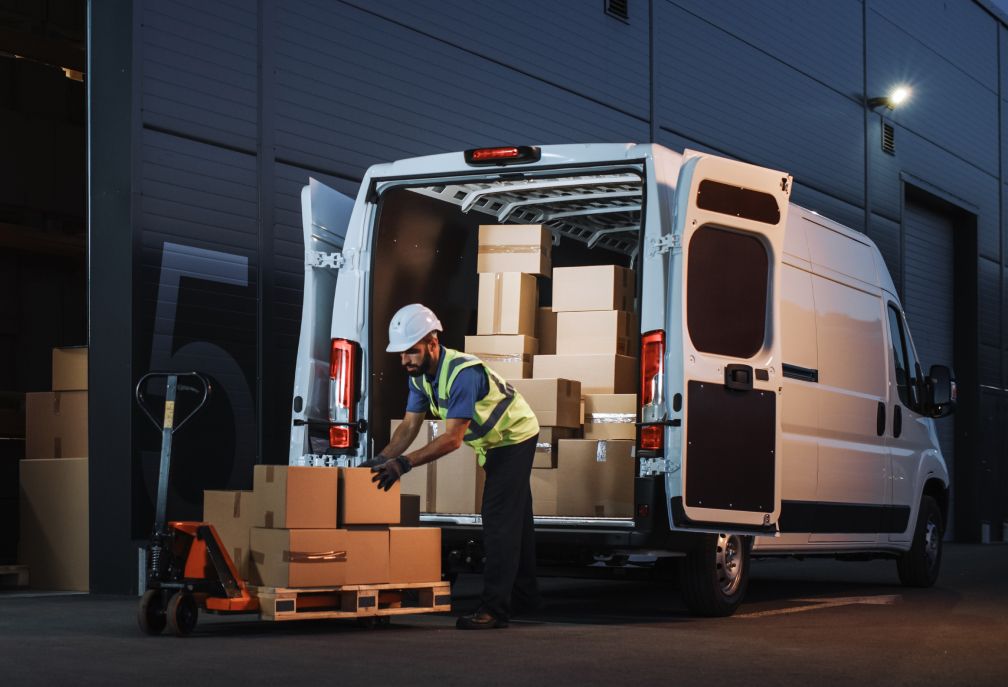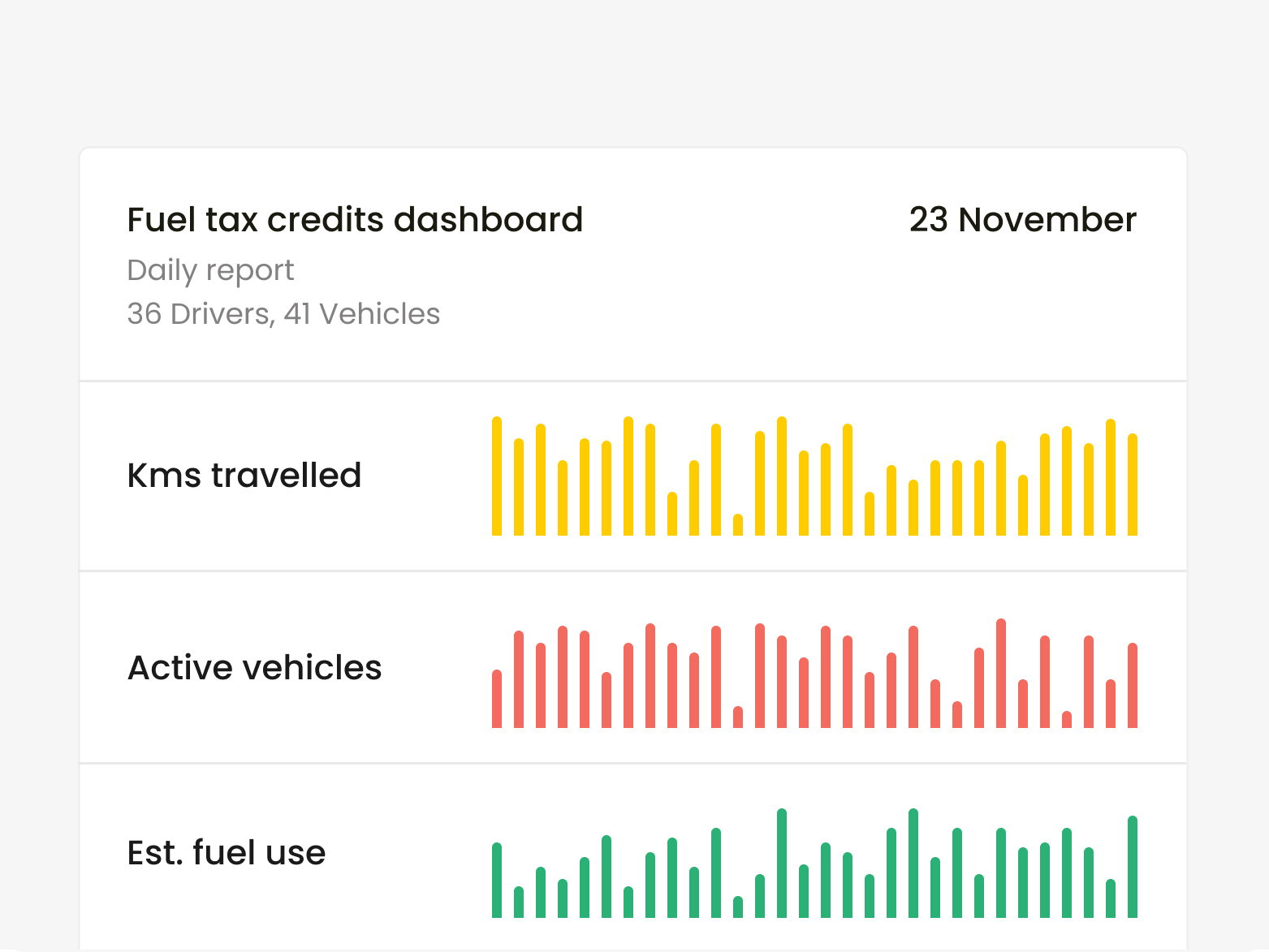Fleet compliance management system
Simplify fleet compliance with automated solutions
Automate the collection of driving data for fatigue management, fuel tax credits (FTC) and Fringe Benefits Tax (FBT) with fleet management software from Inseego. Gain access to additional benefits through Transport Certification Australia (TCA) and improve driver safety standards.

Simplify fleet compliance with automated solutions
Automate the collection of driving data for fatigue management, fuel tax credits (FTC) and Fringe Benefits Tax (FBT) with fleet management software from Inseego. Gain access to additional benefits through Transport Certification Australia (TCA) and improve driver safety standards.

Maximise your return on fuel tax credits
We partner with Prism who work with you to automate the collection of engine data from your fleet vehicles, making it a lot simpler, more accurate and faster to file a monthly return, helping you maximise your refund on the fuel tax credits your business is owed.

Don’t overpay on fringe benefits tax
To minimise yourfringe benefits tax bill, you need to provide the Australian Tax Office (ATO) with logbook records detailing business trips. Our fleet management solution makes it simple for employees to tag trips as business or private, doing away with the need for a lot of tedious and error-prone paper logbooks.

Keep drivers safe with an Electronic Work Diary (EWD)
Our EWD solution (powered by Smart eDriver) eliminates the need for paper log books, automating data collection in real time, maximising allowable driving hours. It makes it easy to plan work schedules and integrate COR reporting (including exceptions).
Additional EWD features to further reduce the risk of fatigue are available, allowing you to proactively manage the health and safety of drivers and respond faster to regulatory compliance breaches (or potential breaches) than traditional log books.

Take advantage of TCA programmes — RIM, TMA & IAP.
As a Transport Certification Australia (TCA) certified service provider, our applications offer higher than Level 1 assurance, including the Telematics Monitoring Application (TMA) and Intelligent Access Programme (IAP). To learn more about the benefits of the National Telematics Framework for fleet operators, visit the TCA website.
Frequently asked questions
What is an Electronic Work Diary (EWD)?
An Electronic Work Diary (EWD) is a digital driver’s logbook solution, and installed as an app on the driver’s mobile device (Android only). It replaces the traditional paper log book and automates recording of driving time, as well as giving drivers a simple tool for planning their work schedule (including rest breaks) and complying with Chain of Responsibility (COR) requirements
Do truck drivers need a log book?
In general, anyone operating a truck with a Gross Vehicle Mass (GVM) of more than 12 tonnes has to comply with the NHVR standards of fatigue management, which includes maintaining a log book. EWDs were introduced to replace paper log books.
What is the advantage of an Electronic Work Diary (EWD)?
There are several key advantages that come from implementing an approved EWD solution:
- Saves time - Drivers have an easy to use app on their mobile devices that pre-populates driving records, eliminating the manual process of keeping a paper log book.
- Maximises allowable driving time - Previously, any trip, no matter how short, was recorded as 15 minutes. Now, journeys are recorded in one-minute increments.
- Faster reporting - With real-time reporting, supervisors can be notified of potential compliance breaches immediately and respond proactively.
- Streamlines admin - As a digital, automated solution, paperwork is reduced, errors are minimised and manual data collection eliminated.
What is fatigue management?
Fatigue management (Basic or Advanced) are a set of rules governing the maximum number of hours that can be driven in a given period, with the minimum amount of rest in between.
These laws are designed to help minimise the risk of commercial vehicle drivers causing accidents due to fatigue and sleep deprivation.
How long does my Advanced Fatigue Management (AFM) certification last?
Certification lasts for two years, but can be shortened or lengthened to align with the expiry dates of your other NHVAS modules.
What is Basic Fatigue Management (BFM)?
BFM regulations are less strict than Advanced Fatigue Management (AFM) and allow up to 14 hours work in a 24-hour period. Operators have more control over when their drivers work, as long as they are managing the risk of fatigue in a responsible manner.
What are the general requirements for fatigue management?
The primary imperative of the fatigue management legislation is that a driver must not drive a fatigue-regulated heavy vehicle on a road while impaired by fatigue.
What is fringe benefits tax (FBT)?
FBT is a tax paid by employers who provide certain benefits to employees that are not subject to regular income tax. For example, FBT is paid on company cars that are available for personal use by employees.
What are fuel tax credits?
GST-registered businesses are eligible to claim back a portion of fuel tax paid that is used by plant equipment, certain heavy machinery and vehicles driven on private roads.
How do fuel tax credits work?
As part of a Business Activity Statement (BAS) return, a business includes records of fuel purchases that are eligible for a fuel tax credit. This includes the fuel type, usage (e.g. driving on private roads) and the applicable rate (see the ATO website for the most recent rates). After the BAS return has been processed, a tax credit is issued to the business.
What are the advantages of using fuel tax credits software?
For many businesses, calculating fuel tax credits manually is too complicated to be worth their time. Using software to automate the process minimises administration time and maximises the calculated credit, making the filing of fuel tax credits profitable.
What is the Intelligent Access Program (IAP)?
IAP is a heavy transport management programme initiated by the Australian Government to improve when and where trucks can travel. Participating transport operators using approved telematics software will get privileged access to specific roads or bridges, and increased payloads. To learn more, visit the TCA website.
What does TMA stand for?
TMA stands for Telematics Monitoring Application. Our GPS trackers (or in-vehicle tracking units, IVUs) allow you to benefit from the TMA. To learn more, visit the TCA website.
How do I introduce GPS fleet tracking to my drivers?
It’s good you are planning to introduce it to the team; this is an important step in improving the success of deploying GPS vehicle tracking across your fleet. Honesty and transparency will help clear up any misunderstandings they may have about fleet tracking.
Firstly, try to anticipate what questions they may have about GPS tracking: Do they not trust us? Will it be used to punish or overwork us? Is it legal? Is it fair? What information is being collected, and will drivers have access to their data?
While GPS fleet tracking is commonly used across both private and public fleets, field service workers will want to know how the technology will apply to them specifically. Reassure them the focus is on improving overall business efficiency, ease of management, minimising paperwork and reducing operating costs. These benefits of GPS fleet tracking help employees too, in several ways:
- Creating a more profitable business increases job security
- A driver’s safe, efficient performance behind the wheel can now be proved (and rewarded) with GPS reports
- Vehicle trackers can minimise the need for paper logbooks and reports
- Supervisors can now track vehicles and see fleet activity in real time, improving coordination of resources and reducing interruptions to drivers with ‘where are you’ calls
- Drivers can monitor and self-manage their safety performance
- Managers can protect drivers from false damage claims or liability in the event of an accident
- Location data can help speed up emergency response
- Tracked maintenance information vehicles can reduce the chance of breakdowns
Work with your team to develop fair policies that improve adoption and reduce the chance mobile workers will feel ‘picked on’ or that it is an invasion of their privacy.
Ctrack consultants can help you to roll out GPS tracking across your business, with advice and suggestions on ways to implement fleet management software that is best for you, your business and your drivers.
How do I know if fleet tracking is right for my business?
If your business has money invested in mobile assets — vehicles, people or assets — then GPS fleet tracking is definitely something you should consider. GPS tracking solutions help you make sure you are using all your mobile resources efficiently.
Without a fleet tracking system, a business could be losing money with under-utilised assets, wasteful driving behaviour or poor job scheduling. GPS fleet tracking makes it easy to identify areas of your business that you can optimise, boosting productivity and reducing running costs.
Fleet tracking can also improve safety, monitoring driver behaviour in real time and encouraging staff to be more responsible.
Why should I choose Inseego over other providers?
Inseego is a global leader in SaaS (Software as a Service), IoT (Internet of Things) and mobile solutions, which means our products are backed by a wealth of experience and expertise in the telematics industry.
Inseego can provide you with a ready-to-use fleet management solution, or customize one to the specific needs and size of your business. We work alongside you as a telematics partner to maximize your ROI.
How do I get started with GPS fleet tracking?
Getting started is easy. Contact us today, let us know a little bit about your fleet and what you would like to achieve and one of our consultants will be in touch to explain how our all-in-one GPS tracking system works, and give an overview of the installation process.
You can also request a demonstration of the fleet tracking software so you can see the GPS tracking in action.
Our telematics consultants have experience with a wide range of different industries and fleet sizes so are in a good position to suggest what features and functions would suit your business best.
How does installation work?
Part of setting up fleet tracking software involves installing GPS tracking devices on vehicles (cars, trucks etc.) and other tracked assets (e.g. trailers, equipment, containers etc.).
Our installer network covers both metro and rural areas. Appointment times are flexible allowing you to schedule an installation time that minimizes any disruption to your business (allow approximately one hour for installing a basic GPS tracking device).
Where is my data stored?
Inseego uses AWS (Amazon Web Services) to store client data securely. The data facility is ISO compliant and provides the safest option available to make sure your data is protected and accessible at all times.
You can read more about the security and reliability features of AWS here.
Will I receive support and training?
Yes, Inseego is committed to working alongside you as a telematics solution partner, helping you maximize the benefit and ROI of your new GPS fleet tracking software. We offer a range of support and training services, designed to fit with the needs of your business and help your staff integrate the software with their daily processes.
Support and training options include:
- Help desk for fast and ready access to technical support
- Remote support to diagnose, troubleshoot and resolve technical issues
- Onsite or remote training workshops to upskill staff
Adding new technology to your business can create some anxiety - our support and training services are designed to make the process of implementing GPS tracking as seamless and trouble-free as possible.
Can I add more vehicles in the future?
Yes, you can update your plan to include additional fleet vehicles (or other GPS tracked assets) at any time.
Simply contact customer support to let us know and we’ll organize the change (and can schedule the installation of the tracking devices if you like).
What GPS tracking hardware can be supplied?
For most vehicles, a standard, wired on-board diagnostics (or OBD-II) plug is fitted, however other types of GPS tracking devices are available including battery powered trackers for non-powered assets (such as containers or trailers).
Let us know if you have specific data collection requirements — in most cases the standard GPS tracking hardware is sufficient for the needs of everyday fleet management.
Is GPS tracking expensive?
Pricing for GPS fleet tracking depends on the specific requirements of your solution, and the number of assets to be tracked.
Our product specialists will work with you to understand your business requirements so they can recommend the most suitable solution for you. You also have the option to purchase the hardware, or rent if that suits your cash flow better.
Inseego are focused on delivering a positive ROI through savings on fuel costs, vehicle maintenance, efficiency and more. This means that in time the fleet management system can actually pay for itself, making it a very viable option for your business.
